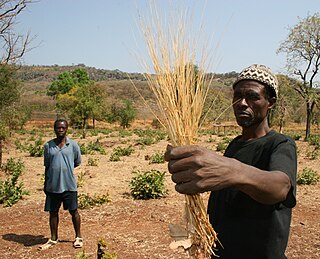
Fonio, also sometimes called findi or acha, is the term for two cultivated grasses in the genus Digitaria that are important crops in parts of West Africa. The nutritious food with a favorable taste is a vital food source in many rural areas, especially in the mountains of Fouta Djalon, Guinea but it is also cultivated in Mali, Burkina Faso, Ivory Coast, Nigeria, and Senegal. The global fonio market was estimated at 721,400 tonnes in 2020. Guinea annually produces the most fonio in the world, accounting for over 75% of the world's production in 2019. The name fonio is from Wolof foño. In West Africa, the species black fonio (Digitaria iburua) and white fonio (Digitaria exilis) are cultivated, whereby the latter is the economically more important crop.

The least bittern is a small heron, the smallest member of the family Ardeidae found in the Americas.

The pygmy mammoth or Channel Islands mammoth is an extinct species of dwarf elephant native to the northern Channel Islands off the coast of California. It was descended from the Columbian mammoth of mainland North America.

Digitaria exilis, referred to as findi or fundi in areas of Africa, such as The Gambia, with English common names white fonio, fonio millet, and hungry rice or acha rice, is a grass species. It is the most important of a diverse group of wild and domesticated Digitaria species known as fonio that are harvested in the savannas of West Africa. The grains are very small. It has potential to improve nutrition, boost food security, foster rural development and support sustainable use of the land. Despite its valuable characteristics and widespread cultivation, fonio has generally received limited research and development attention, which is also why the species is sometimes referred to as an underutilized crop.

The golden-headed cisticola, also known as the bright-capped cisticola, is a species of warbler in the family Cisticolidae, found in Australia and thirteen Asian countries. Growing to 9–11.5 cm (3.5–4.5 in) long, it is usually brown and cream in colour, but has a different appearance during the mating season, with a gold-coloured body and a much shorter tail. It is an omnivore and frequently makes a variety of vocalizations. Known as the "finest tailor of all birds", it constructs nests out of plants and spider threads. It mates in the rainy season. It has a very large range and population, which is thought to be increasing.

Berytidae is a family of the order Hemiptera, commonly called stilt bugs or thread bugs. Most berytids are brown to yellow, with species that are plant sap feeders, a few being predaceous. About 200 species are known from all around the world and they are classified into three subfamilies.
Inga exilis is a species of plant in the family Fabaceae. It is found only in Brazil.
Phasmahyla exilis, the mottled leaf frog, is a species of frog in the subfamily Phyllomedusinae. It is endemic to Brazil. Its natural habitats are subtropical or tropical moist lowland forests and rivers. It is threatened by habitat loss.

The pygmy hanging parrot, red-billed hanging parrot or green hanging parrot is a tiny species of parrot in the family Psittaculidae. It is endemic to forest, mangrove and other wooded habitats on the Indonesian island of Sulawesi. It is becoming rare due to habitat loss.

The grey-breasted crake is a species of bird in subfamily Rallinae of family Rallidae, the rails, gallinules, and coots. It is found in Belize, Costa Rica, Guatemala, Honduras, Nicaragua, Panama, Trinidad and Tobago, and every mainland South American country except Chile and Uruguay.

The pygmy bushtit is a species of bird in the bushtit family Aegithalidae. The species was once placed, along with the rest of its family, with the true tits, Paridae.

The least honeyguide is a small species of bird in the family Indicatoridae. It is found in sub-Saharan Africa.

The Fresno kangaroo rat or San Joaquin kangaroo rat is a species of rodent in the family Heteromyidae. It is endemic to areas within and near the San Joaquin Valley of California in the United States. Habitat destruction due to agricultural development and urbanization has put this species at risk, and the International Union for Conservation of Nature has assessed its conservation status as "vulnerable".
Arganiella exilis is a species of very small freshwater snail with an operculum, an aquatic operculate gastropod mollusks in the family Hydrobiidae. This species is endemic to France.
Agriocnemis exilis is a species of damselfly in the family Coenagrionidae. It is found in Angola, Botswana, Burkina Faso, Cameroon, Central African Republic, Chad, Ivory Coast, Egypt, Ethiopia, Gambia, Ghana, Guinea, Kenya, Liberia, Madagascar, Malawi, Mauritius, Mozambique, Namibia, Nigeria, Réunion, Senegal, Sierra Leone, Somalia, South Africa, Tanzania, Togo, Uganda, Zambia, Zimbabwe, and possibly Burundi.
Paramiacis is an extinct genus of placental mammals from clade Carnivoraformes, that lived in Europe from the middle to late Eocene. Species P. exilis and P. teilhardi were long believed to be the same species, with differences that were only represented as an example of sexual dimorphism.

Phanogomphus exilis, the lancet clubtail, is a species of dragonfly in the family Gomphidae widespread and common throughout southern Manitoba, Ontario, and the northeastern United States.
Pseudamnicola exilis is a species of very small freshwater snail with an operculum, an aquatic gastropod mollusc in the family Hydrobiidae.

Yemma is a genus of stilt bugs in the family Berytidae. There are about five described species in Yemma.

Microcoelia exilis, commonly known as the pinhead orchid, is a species of flowering plant in the orchid family, Orchidaceae. It is a leafless epiphyte, a perennial herb that grows in a tangled cluster of roots and stems on the branch of a tree. This orchid is native to tropical central and eastern Africa and was first described in 1830 by the English botanist John Lindley.













